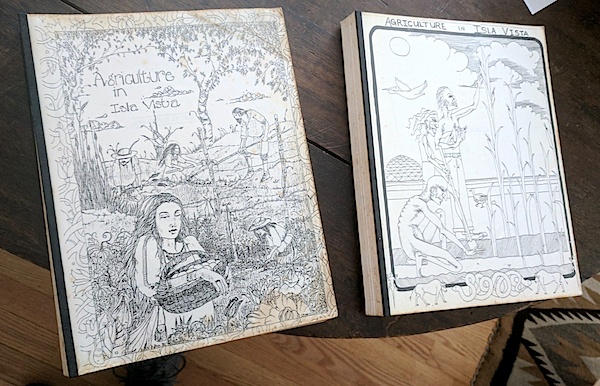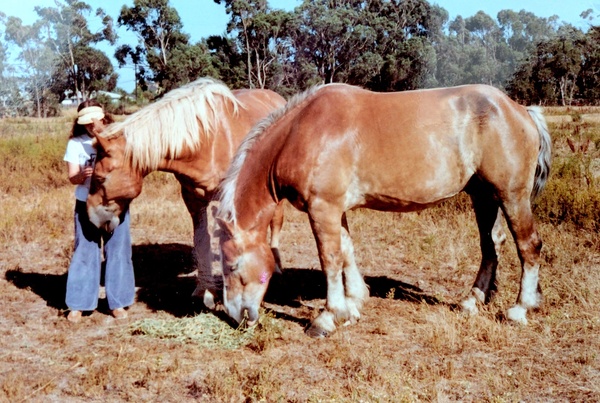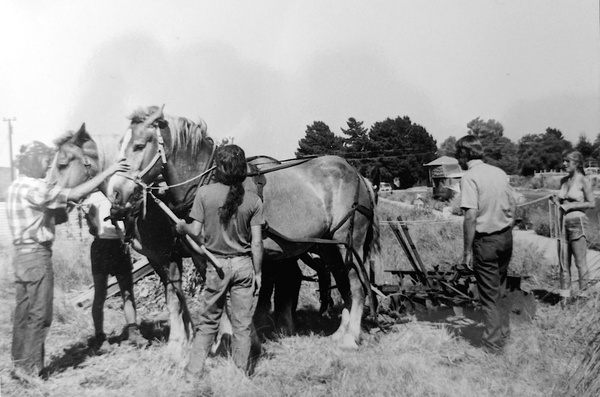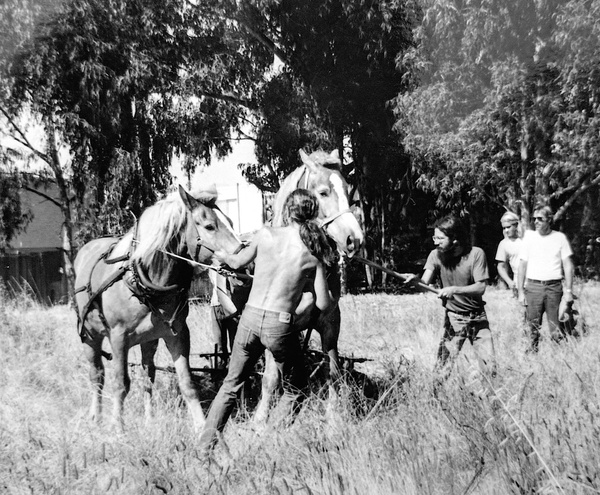The Isla Vista Farm Project was an informal activist group centered around advocating for organic agriculture in the late 1970s. It was to be folded into the Agrarian Division of the Isla Vista Recreation and Park District but grew out of the UCSB Farm Project, a student club on campus. Upon the request and activism of the Isla Vista Farm Project, the Agrarian Division of the IVRPD was formed in May 1978 to be the center of District agricultural activities. [1] The Farm Project was paid $1,200 [2] for their report on organic agriculture. [3]
Agriculture in Isla Vista
In March 1978 the Farm Project delivered its two volume report for the IVRPD called “Agriculture in Isla Vista” whose ambitious goal read: “Our study investigates the methods, costs, and benefits of establishing organic agriculture in Isla Vista. This will be divided into the following major parts: community gardens, an experimental-demonstration center for the exploration of intensive agriculture and alternative technologies, natural preserves, and means of obtaining and storing water.”
 Cover of Agriculture in Isla Vista, artwork by Kathrine Gring
Cover of Agriculture in Isla Vista, artwork by Kathrine Gring
The Farm Project members at the time who worked on the report were Marc Borgman, Joe Doyle, Meredith Meek, Cliff Mitchell, Steve Mitchell, Lisa Nemzer, Eric Nordskog, Cynthia Palmer, Tom Ogden, and Rob Roy.
The Farm Project was also to submit for IVRPD approval, an agreement that would include selling agricultural items for the benefit of the District. It saw itself as a collective and made decisions by consensus of those present, making it was difficult to hash out the formal relationship between the Agrarian Division—made up of Farm Project members, many of whom would not be employees—and the District, raising issues of accountability and funding, among other things. Such an agreement was never created nor signed, and the Agrarian Division never saw itself formally created.
IVRPD Community Gardens
The IVRPD Community Gardens were formally started with the hiring of Farm Project member Marc Borgman in June, 1978, who not coincidentally wrote that section of the report. Although 3 such positions were approved by the District [4] CETA funded only the one, and only for one year. Besides community garden coordination and promotion, Borgman taught classes and wrote a weekly column for the Goleta Today newspaper. [5] In July 1979, Borgman was hired as grounds coordinator overseeing park maintenance and repair, and this now included the community garden program. Regular property tax funds paid for this position. Borgman left the District in 1984, the longest term District employee at the time.
The first IVRPD community garden was established in 1978 behind the Methodist Church on Camino del Sur and Sueno Road. The church paid for the water and was happy to host the gardens. Later community gardens were established around 1979 at Little Acorn after it was purchased in 1978. The Estero Gardens were approved in 1978 but not implemented until 1980, and were immediately filled by the local Hmong community. The organic policy for community gardens was written and approved in 1978 as well.
The experimental garden activities were named The Human Bean Farm, located at the Pink House/Red Barn District office, and was staffed by CETA workers and volunteers. Farm Project members Steve Mitchell and his girlfriend Kathrine Gring were the first ones hired in 1978. When that funding ran out in the early 1980s, the Human Bean Farm was disbanded.
The goals of “alternative technologies, natural preserves, and means of obtaining and storing water” were never investigated by the Agrarian Division, neither was an aquaculture program which had been the work of Joe Doyle. But the District's Community Gardens are still around on Estero Road and very popular.
Draft horses
The one activity that could be called alternative technologies the Agrarian Division did pursue was the purchase of draft horses in 1979 by IVRPD to replace work being accomplished by internal combustion engines. This was an epic failure that ended about a year after it began.
 District board member Andrea Sonnabend with District Belgian draft horse geldings, by Marc Borgman
District board member Andrea Sonnabend with District Belgian draft horse geldings, by Marc Borgman
Hugh Carroll, a long-time ex-Isla Vistan then farming with horses himself in Ojai and who had an extensive history of successful projects in IV (including Counterculture Tiles), was hired by the District to choose the horses, and train employees how to use them. The board named the horses Marx and Mao, but District employees called them Joe and Bud with the encouragement of Hugh Carroll. They were stabled at the West Campus Stables at the time, later at Carroll's farm in Ojai. The project was an attempt to cope with the lack of planning for dealing with the end of the fossil fuel industry. It was idealistic for sure, and naive, and was controversial from the beginning.
The first controversy was over which pool of funding to buy the animals, operating funds (from regular tax revenues) or bond funding (a one-time debt of $1.15 million to buy up and develop park lands). Then locals questioned the wisdom of using draft horses in a densely-populated area like Isla Vista and the effectiveness of the employee training for using the horses.
The final straw was when the horses got spooked and ran away during a training session on Estero Road. Galloping west on Estero with pieces of the equipment trailing behind, one of them fell after grazing a parked van and rolled over with feet flying in the air, then both took off toward the west side of town, ending up at their stable home with only a small leg injury. The van needed $400 in repairs which the District paid for.
The Evangelical Orthodox Church, (later St. Athanasius Church) a conservative break-off of a local Catholic church, brought its members to a board meeting and the horse program ended. [6]
 from left: Brian ? grounds employee, Jade grounds employee, Marc Borgman grounds coordinator, Dave ? agriculture specialist, Lisa Hoffman grounds employee, by Marc Borgman
from left: Brian ? grounds employee, Jade grounds employee, Marc Borgman grounds coordinator, Dave ? agriculture specialist, Lisa Hoffman grounds employee, by Marc Borgman from left: Hugh Carroll horse trainer, Marc Borgman, Rick Ensley board member, Dave ?, by Marc Borgman
from left: Hugh Carroll horse trainer, Marc Borgman, Rick Ensley board member, Dave ?, by Marc Borgman
UCSB Farm Project
The Isla Vista Farm Project grew out from the UCSB Farm Project, which grew from the split up of Ecology Action, and was modeled on the UC Santa Cruz Farm Project. The UCSB Farm Project and Ecology Action were student clubs and received funding from AS. The UCSB Farm Project was originally located where the Events Center is now. Around 1976 it was moved to a spot on Los Carneros where Santa Ynez housing is now. Disturbed by the move from where the Events Center now sits, the student club though they had a permanent site on Los Carneros. The administration did agree to provide an irrigation system if they moved to where the Santa Ynez Apartments now sit, but only the materials for the system, and not the labor needed to design and install it. [7] The UCSB Farm Project is now the UCSB Greenhouse and Garden Project.
Footnotes
[1] IVRPD motions 78-123, 78-137, 78-138, 78-161, 78-162
[2] IVRPD motions 77-267, 77-313, 77-314, 78-22. 77-37
[3] First few pages of Agriculture in Isla Vista Agriculture.in.IV.pdf
[4] IVRPD motion 78-36
[5] Gardening columns in the Goleta Today 12.13.78.GoletaToday.pdf 78.GoletaToday.pdf 01.24.79.GoletaToday.pdf
[7] Letter from UCSB administration to UCSB Farm Project UCSB.FarmProject.pdf


